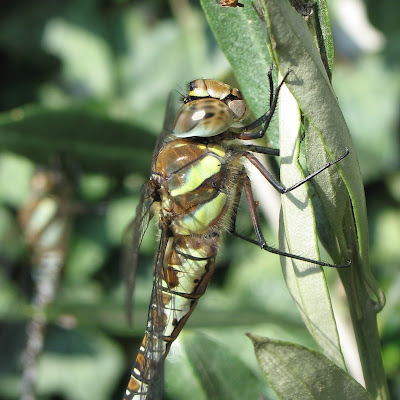A female Migrant Hawker basking, with another individual on the background (16/08/06) - which I only noticed when checking the photos.
Although dragonfly migration has been known for over a century, it is still a little known phenomenon. Several British dragonfly species are regular long-distance migrants, like the Four Spotted Chaser and the Common and Ruddy Darters, and others occasionally appear as vagrants from the Mediterranean or even from North America. Where do they go and why do they do it? Do they migrate back and forth or do they just wander? Is this behaviour to avoid overcrowding or drought, in search for good sites for reproduction? David and Elizabeth Lack (1951) favoured the existence of large scale two way migration in dragonflies, like that of many birds and butterflies, after observing large numbers of Common Darters passing over a high mountain pass in the Pyrenees. American migrants tend to be species breeding in ephemeral or semipermanent ponds, which dry frequently, so migration might also be a wandering in search of suitable ponds. Recently, a combination of miniaturised radio transmitters, isotope analysis and genetic markers have shed light into the migratory behaviour of the American Common Green Darner, Anax junius. Although the Migrant Hawker has been seen forming large swarms, unfortunately, we know very little about the migration in this species. In any case, its migratory behaviour makes it a very good coloniser. In the early 20th century it was regarded as a rare immigrant - in fact it was called Scarce Hawker -, but since an invasion in 1935 it has been steadily and rapidly expanding its range northwards and westwards in the UK, reaching Scotland in 2004. The species also colonised Ireland in 2000 and is now well established. I can't wait to find out more about these fascinating garden visitors.References
Wikelski, M., Moskowitz, D., Adelman, J., Cochran, J., Wilcove, D., and May, M. (2006). Simple rules guide dragonfly migration Biology Letters, 2 (3), 325-329 DOI: 10.1098/rsbl.2006.0487
Lack, D. and Lack, E. (1951). Migration of Insects and Birds Through a Pyrenean Pass The Journal of Animal Ecology, 20 (1) DOI: 10.2307/1644
E.S. Dyatlova and V.J. Kalkman (2008). Massive migration of Aeshna mixta and Sympetrum meridionale in the Ukrainian Danube delta (Odonata-Anisoptera: Aeschnidae, Libellulidae) Entomologische Berichten, 68, 188-190
Brian Nelson, Colm Ronayne and Robert Thompson (2003). Colonization and Changing Status of Four Odonata Species, Anax imperator, Anax parthenope, Aeshna mixta and Sympetrum fonscolombii, in Ireland 2000-2002 The Irish Naturalists' Journal, 27 (7), 266-272




No comments:
Post a Comment